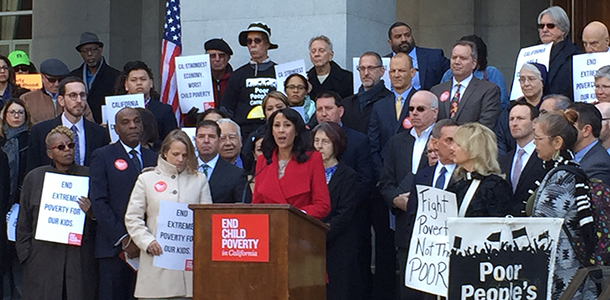
Assembly member Autumn Burke (D-Inglewood) speaking on the steps of the Capitol building Monday in Sacramento for a news conference to introduce recommendations to cut child poverty. (Photo: Deb Kollars)
A cross-section of California leaders, including lawmakers who returned to the Capitol this week for the start of the new two-year session, are pushing into action an ambitious and promising set of strategies for reducing child poverty. Standing side by side Monday on the steps of the Capitol building, business, community, religious and elected leaders committed to taking the next steps needed to implement the recommendations of the recently released report by The Lifting Children and Families Out of Poverty Task Force.
The report concludes that California must significantly increase funding to strengthen early child care and development, housing, health care, and the overall social safety net for low-income families. The Task Force was established under AB 1520, legislation written last year by Assemblywoman Autumn Burke (D-Inglewood) to create a new and comprehensive framework for lifting an estimated one million children out of poverty. The legislation committed the Legislature to a goal of reducing child poverty by 50 percent over 20 years.
The new report is the culmination of a year of work by the Task Force, which included a range of stakeholders and experts focused on child and family well-being, health and human services, workforce development, education, housing, and justice issues. The report takes aim particularly at families living in “deep poverty,” which refers to those with income below half of the federal poverty level (for a family of four, $12,500 a year).
Burke identified the dichotomy of outcomes gripping California as the imperative for moving forward with the Task Force’s recommendations:
“California is the fifth largest economy in the world … and yet we continue to have the highest poverty rate in the nation” said Burke, who added she plans to push legislation establishing several priorities of the Task Force report, including a targeted child tax credit for families in deep poverty, enhanced jobs, and clean and safe shelter for every child.
Conway Collis, co-chair of the Task Force and president and CEO of the anti-poverty organization GRACE, explained that Monday’s news conference at the Capitol was presented in collaboration with many members of Northern California’s Poor People’s Campaign, a nationwide economic justice effort that includes ending child poverty among its initiatives. A key goal of the Task Force report, he said, is to eliminate deep child poverty within four years.
“This is a human, a moral, and a fiscal crisis,” Collis said, pointing out that the Task Force has addressed all of those themes. Its priorities, he noted, include a focus on income supports for families, child care and early childhood education, and coordination of services.
Lenny Mendonca, board chair of Children Now and co-chair of California Forward, noted that the recommendations are backed by solid research and make strong economic sense. He highlighted several important strategies, including expanding home visits to families and guaranteeing access to early learning programs.
The Task Force report’s findings are in alignment with the initiatives of California Forward, which manages the California Economic Summit and has established recommendations for moving more Californians toward an equitable, sustainable and prosperous state. California Forward’s initiatives include achievable strategies for growing quality jobs and a skilled work force, developing reasonably priced housing, preparing children for a changing world and workplace, and lifting people out of poverty.
The strategies contained in the Task Force report “will help ensure the California Dream is available to everyone,” Mendonca said on Monday.
In addition to Burke, other legislators also pledged their commitment to implement elements contained in the Task Force report, including expanded preschool for low-income children (Assembly member Kevin McCarty, D-Sacramento), health care and home visiting services (Assembly member Joaquin Arambula, D-Fresno), housing (Sen. Scott Wiener, D-San Francisco), and foster youth needs (Assembly member Laura Friedman, D-Glendale). These and other initiatives come at the same time Gov.-elect Gavin Newsom, who has expressed support for more early education spending during his campaign, will be taking office in January.
Under the Task Force report’s “phase-in” approach, priority recommendations were developed for directly reducing deep child poverty in a relatively short time frame. Within this group, the plan targets families with very young children and special populations such as children who are homeless or in foster care. As the report explains, the priority recommendations would cost $1.4 billion in 2019-2020, $3.5 billion in 2020-2021, and $5.6 billion in 2021-22. Over the next decade, the total cost of both priority recommendations and longer-term comprehensive costs are estimated at $14 billion.
While the price tag is high, the Task Force report points out that such costs would be offset by about $12 billion a year saved from reductions in juvenile justice, social services and health costs, as well as positive impacts on adult earnings “as today’s children grow up and become more successful adults.”
The Lifting Children and Families Out of Poverty Task Force can be found here.

